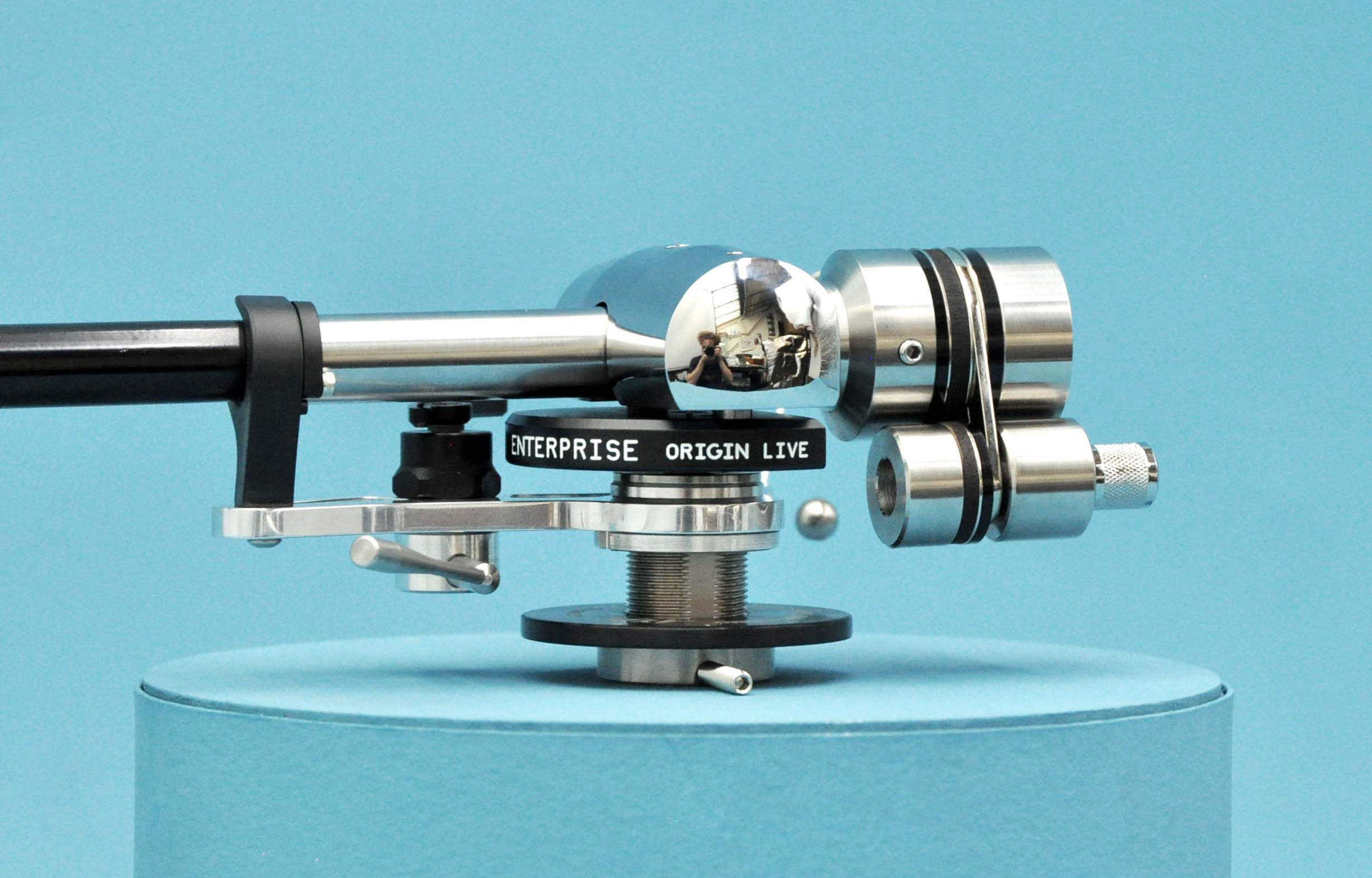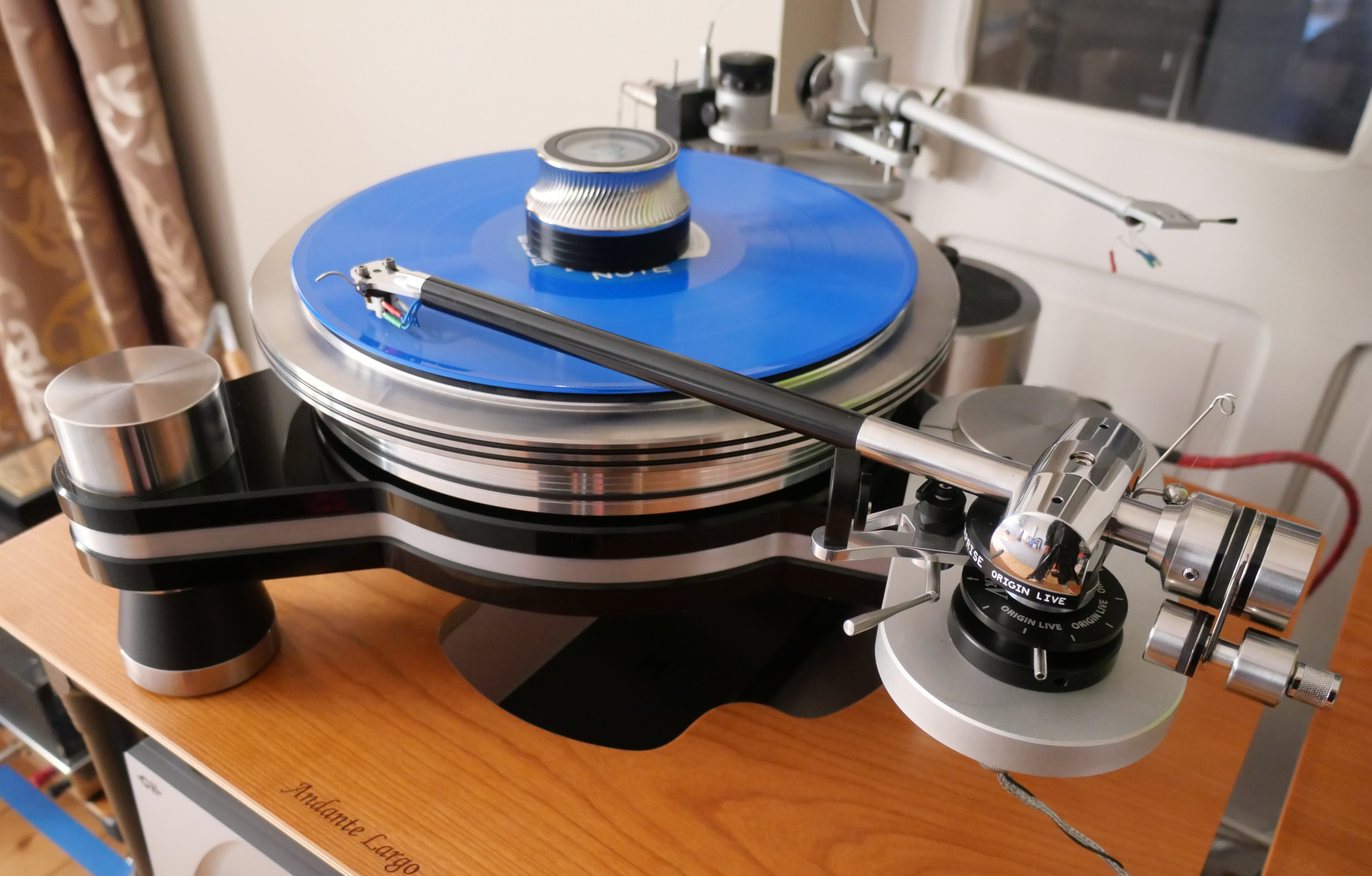
Which finally brings us to VTA, the great bugbear of all sleeve and collar mounted tonearms. Like many other such arms, the Enterprise uses a horizontal wheel, running on the threaded post in order to set/adjust height. But the fact that Origin Live are not pursuing rigidity with the same unquestioning fanaticism as most ‘arm manufacturers gives them an advantage. The threaded post on the Enterprise sits inside a sleeve that is, in turn, locked in the collar. The sleeve sets the arm height, the horizontal wheel allows more precise adjustment of VTA, locked in place with a long allen screw once the desired setting is achieved. By making the VTA adjustment independent of the initial height setting, Origin Live has created a situation in which regular adjustment is entirely possible, even down to record-by-record trimming. Release the VTA locking screw and the whole arm can turn, but, given the smooth running, large diameter wheel, with even a modicum of manual dexterity, it’s easy to both fix the rotational angle of the cueing arm and adjust the VTA. Given a stable record player, like the Grand Prix Monaco or VPI Avenger, it’s perfectly possible to do so in-play. It ain’t a match for a properly designed VTA tower like the one on the Kuzma or VPI arms, but it’s surprisingly workable and way ahead of most other alternative approaches, short of the cost and complexity involved in a tower proper. The Thales Signature is the other arm that can match the Enterprise in this regard, which puts the Origin Live ‘arm in some pretty august company.
In many ways, given the extended evolutionary path that has produced the enterprise, it’s no surprise to find that it’s such a sorted design. The ease and practicality of optimizing it and then using it on a day-to-day basis are first class – as good as any arm of similar type I’ve ever used. The lack of graduation on the various parameters might seem daunting at first, but the adjustment is so intuitive and the results so clearly audible that users can be confident of achieving excellent performance. Indeed, I suspect that those qualities are key to underpinning the superb performance delivered by the Enterprise – and superb it certainly was…
The proof of the pudding…
Although Gidon Kremer’s 1970 recording of the Tchaikovsky Violin Concerto for Melodia (with Temirkanov and the Russian State Symphony Orchestra – later licensed to Eurodisc and RCA in Japan) wasn’t his debut on disc, it was the record that brought him to the attention of the wider, record-buying public. And how! His agile bowing and insistent, angular lines had a dancelike quality, an almost balletic vitality, poise and balance. Set against Temirkanov’s superbly weighted accompaniment and the SSUSSR’s brilliant ensemble playing, the live concert performance was a revelation, breathing vivid new life into a hackneyed orchestral warhorse.

Playing the Japanese pressing (RCA VIC-2049), the Enterprise, sandwiched between the Fuuga cartridge and the VPI Avenger ‘table captured the character and immediacy of the performance perfectly. Kremer’s solo instrument is slightly over-voiced and larger than life, set against a beautifully defined and contiguous acoustic space. The orchestral soundstage is clearly laid out, in both width and depth, but it’s the incisive precision in Kremer’s bowing, his attack, purpose and dynamic shading that are so captivating. Temirkanov takes a back-seat, perfect in his supporting role, deft when required, weighty when the score demands. But what makes this performance so impressive is the lucid speed, uncluttered clarity, dynamic stability and lack of musical inertia delivered by the Enterprise. Given the rich, powerful balance of the cartridge and the big, smooth, flowing sound of the VPI ‘table, it’s a match made in musical heaven. There’s a pace and momentum to the presentation that perfectly matches Kremer’s musical intent – and which reflects the balanced weighting of the sound. There’s no excess fat slowing down the bottom end, no dips or smearing robbing the midrange of space, presence or urgency, no smoothing or premature roll-off to rob the acoustic of air. Instead, Kremer’s measured intensity, his beautifully controlled and almost acrobatic lines, sharp corners and sudden swerves are projected in all their glory. Kremer can play – and the Enterprise allows the Fuuga to leave you in no doubt of that.

